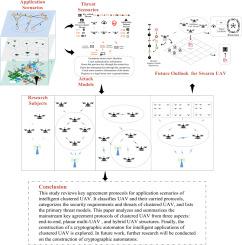Intelligent UAV swarm key agreement survey: Systematic taxonomy, cryptographic automaton and quantum resistance
IF 7.6
3区 计算机科学
Q1 COMPUTER SCIENCE, INFORMATION SYSTEMS
引用次数: 0
Abstract
Unmanned Aerial Vehicle (UAV) swarms are vital for intelligent applications that require robust key agreement protocols to address dynamic network security challenges. This paper systematically reviews protocols for intelligent UAV swarms, addressing the gaps in existing research. It classifies UAV and embedded protocols based on autonomy and computational capabilities, defines security requirements, and establishes threat models for swarm dynamics. Protocols are categorized into three architectures: end-to-end for ground-UAV communication, planar multi-UAV for decentralized peer-to-peer management, and hybrid hierarchical systems for large swarms. A core contribution is the cryptographic automaton, an adaptive framework for autonomous security management that integrates dynamic key generation, context-aware adjustments, and quantum resistance to handle real-time topology changes and emerging threats. The paper merges structural classifications with threat analysis to identify solution gaps and propose scalable, cryptographic automaton-based, and quantum-resistant directions. It establishes a foundation for secure UAV swarm key agreement, with future research focusing on refining the automaton for practical applications.

智能无人机群密钥协议调查:系统分类、密码自动机和量子抵抗
无人机(UAV)群对于需要强大的关键协议协议来应对动态网络安全挑战的智能应用至关重要。本文系统地回顾了智能无人机群的协议,解决了现有研究中的空白。它基于自主性和计算能力对无人机和嵌入式协议进行分类,定义安全需求,并建立群体动力学的威胁模型。协议被分为三种架构:端到端用于地面无人机通信,平面多无人机用于分散的点对点管理,以及用于大型蜂群的混合分层系统。核心贡献是加密自动机,这是一个用于自主安全管理的自适应框架,它集成了动态密钥生成、上下文感知调整和量子抵抗,以处理实时拓扑变化和新出现的威胁。本文将结构分类与威胁分析相结合,以识别解决方案差距,并提出可扩展的、基于密码自动机的和抗量子的方向。这为安全的无人机群密钥协议奠定了基础,未来的研究重点将放在改进实际应用中的自动机上。
本文章由计算机程序翻译,如有差异,请以英文原文为准。
求助全文
约1分钟内获得全文
求助全文
来源期刊

Internet of Things
Multiple-
CiteScore
3.60
自引率
5.10%
发文量
115
审稿时长
37 days
期刊介绍:
Internet of Things; Engineering Cyber Physical Human Systems is a comprehensive journal encouraging cross collaboration between researchers, engineers and practitioners in the field of IoT & Cyber Physical Human Systems. The journal offers a unique platform to exchange scientific information on the entire breadth of technology, science, and societal applications of the IoT.
The journal will place a high priority on timely publication, and provide a home for high quality.
Furthermore, IOT is interested in publishing topical Special Issues on any aspect of IOT.
 求助内容:
求助内容: 应助结果提醒方式:
应助结果提醒方式:


